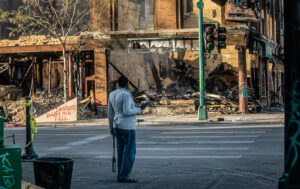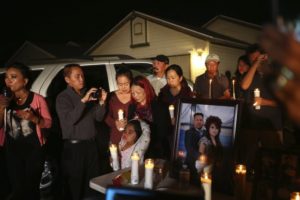Evidence that the great American melting pot is a myth was in evidence everywhere this past dreadful week, but no where quite so clearly as Lake Street, Minneapolis—America’s “landmark street of diversity.”

In a few weeks, on July 1, Refugee Resettlement Watch will celebrate its 13th anniversary.
During that summer of 2007, when many people in my rural county wanted to understand how we had been ‘chosen’ as a new refugee resettlement site, a story at City Journal caught my eye and for years it was linked on the header of the old RRW (prior to the speech police killing the old site).
Until that summer and fall of 2007, I am sorry to say, I hadn’t given any of this much thought.
Now, I think this is a good time to remind people of the research published that year by Harvard researcher, Robert Putnam, who by all accounts feared the release of his study which had concluded that, despite assurances by the Leftwing promoters of ever-more immigration that diversity brings strength, it does not!
Here is a bit of John Leo’s report at City Journal from June 2007:
Bowling With Our Own
Robert Putnam’s sobering new diversity research scares its author.

Harvard political scientist Robert Putnam, author of Bowling Alone, is very nervous about releasing his new research, and understandably so.
His five-year study shows that immigration and ethnic diversity have a devastating short- and medium-term influence on the social capital, fabric of associations, trust, and neighborliness that create and sustain communities.
He fears that his work on the surprisingly negative effects of diversity will become part of the immigration debate, even though he finds that in the long run, people do forge new communities and new ties.
What we are seeing in places like Minneapolis, the multiculti capital of Minnesota, might suggest that Putnam was expressing some wishful thinking when he predicted that new (mixed) communities would forge.
How many decades is that supposed to take I want to know! And, will America survive until then?
Putnam’s study reveals that immigration and diversity not only reduce social capital between ethnic groups, but also within the groups themselves. Trust, even for members of one’s own race, is lower, altruism and community cooperation rarer, friendships fewer.
The problem isn’t ethnic conflict or troubled racial relations, but withdrawal and isolation. Putnam writes: “In colloquial language, people living in ethnically diverse settings appear to ‘hunker down’—that is, to pull in like a turtle.” [Seems to me that troubled race relations are evident!—ed]
In the 41 sites Putnam studied in the U.S., he found that the more diverse the neighborhood, the less residents trust neighbors. This proved true in communities large and small, from big cities like Los Angeles, Chicago, Houston, and Boston to tiny Yakima, Washington, rural South Dakota, and the mountains of West Virginia. In diverse San Francisco and Los Angeles, about 30 percent of people say that they trust neighbors a lot. In ethnically homogeneous communities in the Dakotas, the figure is 70 percent to 80 percent.
Diversity does not produce “bad race relations,” Putnam says.
Putnam was wrong about that as we see in Minneapolis and other recently destroyed cities. The rioters (mostly blacks or antifa thugs) showed little or no concern for the minority shop owners as they raged at the white man.
“Give pause to those on the left”—what a joke!
Though Putnam is wary of what right-wing politicians might do with his findings, the data might give pause to those on the left, and in the center as well. If he’s right, heavy immigration will inflict social deterioration for decades to come, harming immigrants as well as the native-born.
Putnam is hopeful that eventually America will forge a new solidarity based on a “new, broader sense of we.” The problem is how to do that in an era of multiculturalism and disdain for assimilation.
More evidence from Lake Street that race relations there are not going smoothly….

One of the police officers fired and now arrested in the killing of George Floyd is clearly a minority hire for the Minneapolis police—a man from the large Hmong ethnic group that was “plopped” down in Minnesota (in a poor black neighborhood) in the wake of the Vietnam war.
If it weren’t for the fact that Tou Thao was arrested, we wouldn’t know that tensions were running high between the black and Asian members of the ‘community.’
It is another theme that the Left loves to perpetuate—that those who have supposedly been oppressed will band together and support each other—but has again shown to be a lie.
His involvement in Floyd’s death will only exacerbate already existing tensions.
From NPR:
The debate over Thao’s real or perceived complicity as another man of color is killed has arrived in a community that has always had underlying tensions with its black neighbors.
This goes back to the 1970s, when the Hmong arrived as refugees and were “plopped into the most affordable parts of town,” says Bo Thao-Urabe, a Hmong refugee and head of the Coalition of Asian American Leaders in St. Paul. She has no known relation to former officer Thao.
“So we live in proximity to black and brown people,” she says. But even though Asian Americans were able to help grow neighborhoods like Frogtown into vibrant communities of color, there has always been tension.
There is much more worth reading, click here for the entire sad story about how diversity isn’t bringing strength. How many more Lake Streets will it take to convince our elected officials that more immigration and more trumpeting about the joys of diversity is a fools errand.
The hard truth is that people want to live with their own kind of people. Why else would Somalis who might have been “plopped” in some other state, pick up and move to Minnesota in such large numbers.
By the way, just so you know, Minneapolis is diverse not because various ethnic groups arrived in America and “made their way” (how many times have I heard that phrase in 13 years!) to Minnesota because they heard it was a nice place to live.
They are in Minnesota because the US State Department and the refugee contractors (the Catholics, the Lutherans, etc.) worked in concert for the last five decades to place them there with naive notions about a great American melting pot!



 Note to PayPal donors! I want to thank all of you who send me donations for my work via PayPal. I very much appreciate your thoughtfulness. However, PayPal is making changes to their terms of service and I’ve decided to opt-out beginning on March 10, 2020.
Note to PayPal donors! I want to thank all of you who send me donations for my work via PayPal. I very much appreciate your thoughtfulness. However, PayPal is making changes to their terms of service and I’ve decided to opt-out beginning on March 10, 2020.

